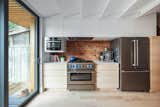How They Pulled It Off: A Ceiling That Conceals Recessed Lighting
Welcome to How They Pulled It Off, where we take a close look at one particularly challenging aspect of a home design and get the nitty-gritty details about how it became a reality.
When photographer Andrew Rowat and his longtime friend and former officemate, architect Delnaz Yekrangian, began renovating his Toronto townhouse, they were already operating under a compressed timeline. Rowat, in short order, got married, became a father, and welcomed his first son, and the home, located in the city’s Roncesvalles neighborhood, was in need of a gut renovation.
The arrival of the pandemic, Yekrangian explains, threw an additional wrinkle into the work, but she and Rowat devised a plan: "We had to be very strategic about where we could interfere or intervene with the existing house and where we couldn’t," says the founding partner at Aleph-Bau. Rowat, who previously split his time between New York and Shanghai, has photographed spaces and structures on all seven continents, and Yekrangian, also based in Toronto, has worked in Rotterdam, San Francisco, and her native Iran, with an emphasis on repurposing existing buildings. The pair met when they held adjoining studios in a former distillery building, and have stayed friends for nearly a decade, leaping at the chance to collaborate on a project that allowed them to put their combined talents to use.
Yekrangian says Rowat is detail-oriented (so much so that he served as the project manager of the entire renovation), and the team looked for spots to create, as she puts it, "space to do something a little bit different—and also to have some fun."
One such spot was the kitchen, where space came at a premium. To add both visual interest and a system for concealing light fixtures, Rowat and Yekrangian looked up—at the ceiling, to be exact. One of Rowat’s goals was to create indirect light; the house, he says, did have recessed lighting, but he wanted to use them as infrequently as possible. With these two goals in mind, the pair devised a clever solution.
How they pulled it off: A paneled ceiling that cleverly conceals lighting
- Sourcing materials for the paneling was easy: they went to Home Depot and picked up particle board, which was then painted to match the walls.
The paint was Benjamin Moore Chantilly Lace OC-65 meant to match both the cabinetry and the Corian countertops.
The slope in the ceiling panels also serves another need: it conceals a 10-inch exhaust pipe for a six-burner Bluestar range.
It’s a very small space, so we just really followed the modules of the kitchen cabinets, which themselves were mostly driven by function," says Yekrangian.
Behind the sloped ceiling, they also filled the voids with sound attenuation material to prevent noise from traveling into Rowat’s young son’s bedroom.
"I think credit really goes through Andrew himself," Yekrangian says of getting the project done. "We do a lot of designs and, especially in the beginning when we’re having conversations, we usually share lots of sketches, lots of rendering, lots of drawings, and 99 percent just are thrown out the window. But Andrew and his wife, they liked it and they did really follow through!"
Rowat was pleased with the results, and in retrospect, appreciates that they kept it simple: "With regards to the ceiling, I had entertained the idea of coming up with a more exotic approach to affixing the panels, but in the end the headache wasn’t going to be worth it—I think my contractors would have fired me, and the end result was awesome."
Related Reading:
Published
Last Updated
Topics
How They Pulled It OffGet the Dwell Newsletter
Be the first to see our latest home tours, design news, and more.



